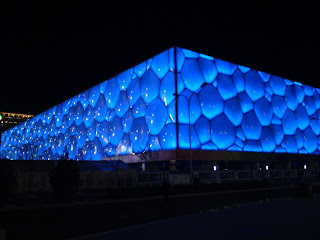 |
| The Great Wall of China One of Seven Wonders of the World |
BEIJING, China - We went to Great Wall of China on one weekend of November 2009 during our assignment in Dalian. It was winter that time so it was very cold and snowy and the floor was slippery.
We went on Saturday and contracted a taxi to bring us to the wall. My colleague and I were excited. It was our first time to see The Great Wall and it was my first time to see one of the seven wonders of the world. I was imagining how The Great Wall looks like and I was really surprised to see it. It was fascinating how the people made such a wonder that expands to thousands of kilometers.
 |
| The Great Wall of China |
Wikipedia describes The Great Wall of China as a series of fortifications made of stone, brick, tamped earth, wood, and other materials, generally built along an east-to-west line across the historical northern borders of China in part to protect the Chinese Empire or its prototypical states against intrusions by various nomadic groups or military incursions by various warlike peoples or forces.
Several walls were being built as early as the 7th century BC; these, later joined together and made bigger, stronger, and unified are now collectively referred to as the Great Wall. Especially famous is the wall built between 220–206 BC by the first Emperor of China, Qin Shi Huang. Little of that wall remains. Since then, the Great Wall has on and off been rebuilt, maintained, and enhanced; the majority of the existing wall was reconstructed during the Ming Dynasty.
Several walls were being built as early as the 7th century BC; these, later joined together and made bigger, stronger, and unified are now collectively referred to as the Great Wall. Especially famous is the wall built between 220–206 BC by the first Emperor of China, Qin Shi Huang. Little of that wall remains. Since then, the Great Wall has on and off been rebuilt, maintained, and enhanced; the majority of the existing wall was reconstructed during the Ming Dynasty.
 |
| The Cube Venue of Swimming Competition Beijing Olympics 2008 |
Other purposes of the Great Wall have included border controls, allowing the imposition of duties on goods transported along the Silk Road, regulation or encouragement of trade and the control of immigration and emigration.
Furthermore, the defensive characteristics of the Great Wall were enhanced by the construction of watch towers, troop barracks, garrison stations, signaling capabilities through the means of smoke or fire, and the fact that the path of the Great Wall also served as a transportation corridor.
Furthermore, the defensive characteristics of the Great Wall were enhanced by the construction of watch towers, troop barracks, garrison stations, signaling capabilities through the means of smoke or fire, and the fact that the path of the Great Wall also served as a transportation corridor.
The Great Wall stretches from Shanhaiguan in the east, to Lop Lake in the west, along an arc that roughly delineates the southern edge of Inner Mongolia.
A comprehensive archaeological survey, using advanced technologies, has concluded that the Ming walls measure 8,850 km (5,500 mi). This is made up of 6,259 km (3,889 mi) sections of actual wall, 359 km (223 mi) of trenches and 2,232 km (1,387 mi) of natural defensive barriers such as hills and rivers. Another archaeological survey found that the entire wall with all of its branches measure out to be 21,196 km (13,171 mi).
A comprehensive archaeological survey, using advanced technologies, has concluded that the Ming walls measure 8,850 km (5,500 mi). This is made up of 6,259 km (3,889 mi) sections of actual wall, 359 km (223 mi) of trenches and 2,232 km (1,387 mi) of natural defensive barriers such as hills and rivers. Another archaeological survey found that the entire wall with all of its branches measure out to be 21,196 km (13,171 mi).
 |
| The Nest Venue of the Opening Ceremony Beijing Olympics 2008 |
We also went to some historical places in Beijing at night. I consider them historical although they are modern structures because these venues made history.
We went to "The Cube" which is the venue for swimming competition in the 2008 Beijing Olympics and to "The Nest" which was the venue for the Opening Ceremony. We were not able to get in but I can see from outside that they are world-class and unique structures.
We went to "The Cube" which is the venue for swimming competition in the 2008 Beijing Olympics and to "The Nest" which was the venue for the Opening Ceremony. We were not able to get in but I can see from outside that they are world-class and unique structures.
I enjoyed our side trip to Beijing. I am glad to see a very modern yet historical city that is truely world-class.
No comments:
Post a Comment